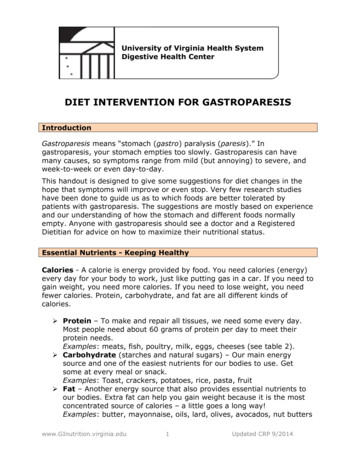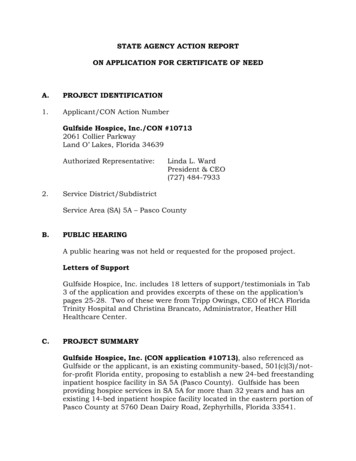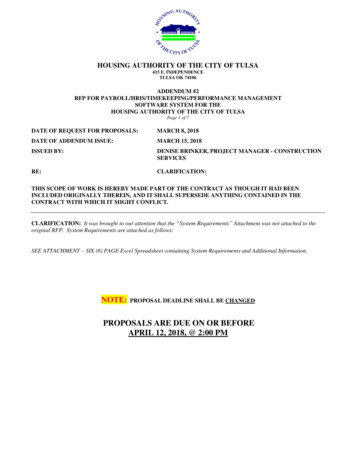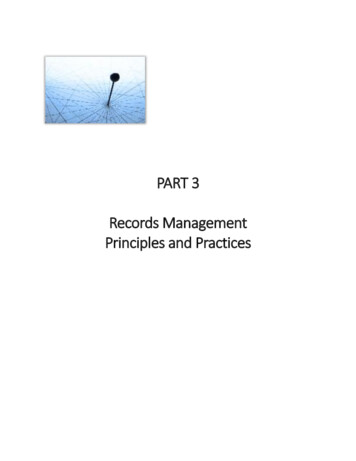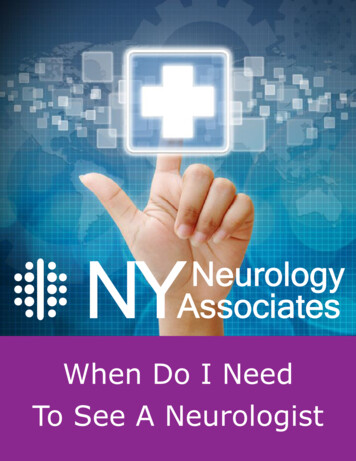
Transcription
When Do I NeedTo See A Neurologist
When Do I Need To See A Neurologist1When Do I Need To See A NeurologistThe human body is a complex, sophisticated machine, both adaptable and vulnerable toits environment. Your primary care physician is your first line of defense when it comesto your health, assuming the role of diagnostician, immunizer, counselor, and providingpreventive care and chronic illness management.Since the human body consists of many different systems, 206 bones, 200 types of cellsand is prone to a number of possible conditions and diseases, it’s easy to see why specialized medicine exists. Neurology is one such specialty, and the aim of this guide is tohelp the patient determine when a visit to a neurologist is necessary by identifying thosesymptoms associated with various neurological disorders.Share this book:Facebook Twitter Pinterest Google LinkedInwww.nyneurologists.com
When Do I Need To See A NeurologistWhat is a Neurologist?23 Describes the job of a neurologistThe Nervous System3 Outlines functions of both nervous systemsWhat to Expect During the ViSit5 Details the procedure of a visitList of Common Neurological Disorders6 Explains symptoms/diagnosis/treatments of disorders- Dementia6- Alzheimer’s Diease7- Multiple Sclerosis10- Epilepsy12Other Neurological Conditions17 Provides information on milder conditions- Cerebral Palsy17- Parkinson’s Disease18- Scoliosis19- Headaches20- Dizziness or Balance Issues23- Head and/or Neck Pain24- Back Pain25- Myasthenia Gravis26conclusion28 Quick tips for finding a neurologistShare this book:Facebook Twitter Pinterest Google LinkedInwww.nyneurologists.com
When Do I Need To See A Neurologist3Introduction to NeurologyWhat is a Neurologist?This type of physicianOn average they will haveis trained to care for allcompleted 12 or moreaspects of a patient’syears of formal educationhealth in relation toand training. Many willdiseases or disorders ofcontinue to further theirthe nervous system, witheducation and focus on athe exception of surgery.subspecialty such as pediatricneurology, sleep or painmedicine.The Nervous SystemThis complex network is responsible for communicating with and controlling your entirebody as well as sending and receiving messages that regulate thought and movementwith two major divisions: The central nervous systeminvolving the brain and spinal cord The peripheral nervous systemcomprised of cranial and spinal nervesThe cells that make up both systems are called Neurons, which transmit informationchemically and electrically throughout the body. As the body’s central command unit,the Brain is made up of billions of neurons which fire any time you think or respond to astimulus. There are three fundamental parts to the brain:Share this book:Facebook Twitter Pinterest Google LinkedInwww.nyneurologists.com
When Do I Need To See A Neurologist 4CerebrumWhere thinking occurs and the area that controls allsenses and voluntary movements Cerebellum Brain stemResponsible for balance and coordinationThe vital link to the spinal cord, also controllingbreathing, digestion, and heartbeatThe Spinal CordThe spinal cord is a tubular bundle of nerve fibers, that runs down the center of the backand is protected in part by spinal fluid and hard vertebrae. The nerves located withinbranch off to exit at various levels, carrying information from the spinal cord throughout the body and information gathered from the body back up to the brain. These levelsinclude: Cervical nervesLocated in the neck area, these nerves control breathing, and supply feeling and movement to the arms,upper trunk, and neck Thoracic nerves Lumbar and sacral nervesNerves in this area of the upper back branch out tothe abdomen and trunkNerves which supply the bladder, bowels, legs andsexual organs are located in these areas of the lowerbackShare this book:Facebook Twitter Pinterest Google LinkedInwww.nyneurologists.com
When Do I Need To See A Neurologist5What to Expect During Your VisitWhat is a Neurologist?Your type of insurance will determine whether or not you require a referral from yourprimary physician, and the length and scope of the visit will depend on your chiefmedical complaint and medical history.After the initial consultation, the neurologist will begin the physical diagnostic exam, thespecifics of which are reliant upon the nature of the symptoms and may include: Testing of the reflexesChecking yourlocomotive capabilities Testing coordination and balanceVision or sensory awareness testingAt the conclusion of the visit, the doctor may: Order further diagnostic or lab testingPrescribe or provide sample medicationsSchedule a follow-up visitFinding a Neurologist in Your AreaThere are more than 16,000 neurologists currently practicing in the United States andthe easiest way to locate one in your area is to visit the American Academy of Neurologywebsite and search their extensive database.Common Types of Neurological DisordersThere are over 600 different types of neurological disorders, most of which are virtuallyunheard of outside of a doctor’s office. Millions of people across the globe are affectedby them, each requiring some form of treatment; here are some of the more commontypes:Share this book:Facebook Twitter Pinterest Google LinkedInwww.nyneurologists.com
When Do I Need To See A Neurologist6Dementia (Memory Problems)is a general term that describes problems with memory and mental function. Memoryproblems tend to be associated with normal aging, but dementia is not. Dementia beginsgradually in most cases and worsens over time. It severely disrupts one’s quality of life.Symptoms of dementia include: Memory LossInappropriate behaviorHallucinationsImpaired judgmentDifficulty thinkingImpaired motor functionsThe following are progressive dementias which worsen over time: Alzheimer’s DiseaseLewy Body DementiaVascular DementiaFrontotemporal DementiaAs there is no cure, dementia can onlybe managed in the following ways: Occupational therapyMedicationCholinesterase inhibitorsIf you or a loved one is experiencing any of these symptoms, see a neurologist to ruleout any other possible causes. Several treatable conditions may cause dementia-likesymptoms and it is important to rule those out before making a proper diagnosis.Share this book:Facebook Twitter Pinterest Google LinkedInwww.nyneurologists.com
When Do I Need To See A Neurologist7Alzheimer’s DiseaseThis fatal, degenerative, and progressive disease is a form of dementia – a broad termused to explain memory loss and other symptoms that interfere with daily life.Possible CausesDefinitive causes for Alzheimer’s are currently unknown but there are severalrisk factors linked to thisdisease: Age Genetics Ongoing researchIncreased age is number one; the majorityof Alzheimer patientsare 65 or older, thoughsymptoms can beginas early as 30 as in thecase of the early-onsetform of the diseaseCertain genes do tend to increase a person’s risk ofacquiring Alzheimer’s, though it’s not a guarantee andgenetic testing is rarely doneAdditional risk factors being studied include alcoholand tobacco usage, diet and exercise, environmentalfactors, and preexisting conditions or diseasesShare this book:Facebook Twitter Pinterest Google LinkedInwww.nyneurologists.com
When Do I Need To See A Neurologist8SymptomsThe progression of Alzheimer’s disease begins slowly, evolving over time from mild tomoderate and finally severe. Common symptoms and warning signs include: Short term memory loss or mild confusionMemory loss can worsen as the patient forgets important dates and names, repeats the same statement or question over and over, misplaces objects by puttingthem in odd places, and eventually fails to recognize common objects and lovedones Behavioral changesAs changes occur in the brain, so can the actions and feelings of the patient, potentially resulting in:- Aggressiveness- Distrustfulness- Changes in sleeping patterns- Irritability- Delusions- Mood swings- Depression- Social withdrawal- Difficulty sleeping Problems with written and verbal communicationThe patient may have difficulty finding the words to effectively communicate andeventually lose the ability to read or write. DisorientationAs the disease progresses, it may become more difficult to recognize once familiarsurroundings or to know the date, day, or season.Share this book:Facebook Twitter Pinterest Google LinkedInwww.nyneurologists.com
When Do I Need To See A Neurologist9Diagnosis/TreatmentSince there is no single definitive test for Alzheimer’s, diagnosis requires a careful andthorough medical evaluation. Part of the diagnostic criteria involves confirmation ofmemory loss with cognitive testing, and at least one or more of the following: Abnormal speechImpaired judgment, problem solving or planningImpaired performance of learned motor skillsFailure to recognize familiar people or objectsFurther examination and evaluation by a neurologist mayinclude: A thorough review of the patient’s medical historyNeurological and physical examinationsBlood and brain imaging testing to help rule out other conditionsThere is currently no cure for this disease, but a neurologist may suggest or prescribe medicinal or nonmedicinal treatments to help with behavioral and cognitive symptoms.Share this book:Facebook Twitter Pinterest Google LinkedInwww.nyneurologists.com
When Do I Need To See A Neurologist10Multiple SclerosisMultiple sclerosis, or MS, is a chronic disease that attacks thecentral nervous system (CNS) and more specifically, myelin – theprotective coating surrounding the nerve fibers in the CNS. As themyelin is damaged it forms scar tissue, or sclerosis, which givesthis disease its name. When these fibers become damaged ordestroyed, communication between the brain and the spinal cordbecomes garbled, producing a multitude of symptoms.Possible CausesAs with many neurological disorders the cause of MS is currently unknown though theories exist involving: ImmunityMyelin damage is thought to be due to an unnatural response by the body’s immunesystem in which it attacks the myelin, though what triggers the attack is unknownGeneticsMS is not inherited in the traditional sense, but researchers have managed to identify specific genes that put certain people at a higher risk for MSEnvironmental TriggersThere is a greater occurrence of MS in areas farther from the equator. Possible theories surrounding this phenomenon are vitamin D levels from exposure to sunlightand exposure to certain environmental agents prior to pubertyVirusesWhile there is no definitive link between a particular virus and MS, the Epstein-Barrvirus is considered a possibilityShare this book:Facebook Twitter Pinterest Google LinkedInwww.nyneurologists.com
When Do I Need To See A Neurologist11SymptomsMS symptoms and their progression are unpredictable and vary from patient to patient,most commonly including: Balance/coordination issuesBladder or bowel dysfunctionCognitive issuesDepressionDizziness or vertigoEmotional issuesFatigueMuscle spasms, pain or stiffnessNumbnessPainSexual dysfunctionTrouble walkingVision problemsDiagnosis/TreatmentThere is no cure for MS, but there are a number of effective treatments your neurologistmay prescribe to slow it’s progression, manage symptoms, improve function and qualityof life, and treat flare-ups. Treatment plans are tailored to each individual’s needs andmay include: A variety of medications, steroidal and non-steroidalDiet modificationsExercisePhysical therapyShare this book:Facebook Twitter Pinterest Google LinkedInwww.nyneurologists.com
When Do I Need To See A Neurologist12EpilepsyEpilepsy is a medical condition affecting the nervous system, which causes the patientto have unprovoked seizures. Also referred to as a “seizure disorder”, epilepsy iscategorized by type, often called epilepsy syndromes, defined by: Age on onset of seizuresFamily historyElectroencephalogram (EEG) resultsMedical imagery resultsType of seizurePrognosisSeizures occur when a group of brain cells which normally communicate with each otherthrough small electrical spurts of activity, have a sudden, irregular burst, which cancause confusion, convulsions and loss of awareness.Possible CausesIn the majority of cases (60 to 75 percent) the cause of this condition is unknown butfor those that are, causes include: Alcohol or drug abuseBrain traumaBrain tumor GeneticssInfectionStrokeDevelopmental disorderInjury or lack of oxygen at birthDegenerative disorder, such as Alzheimer’s diseaseShare this book:Facebook Twitter Pinterest Google LinkedInwww.nyneurologists.com
When Do I Need To See A Neurologist13SymptomsA person who has had two or more seizures is defined as having epilepsy. Symptoms canvary from person to person but all have a: Beginning Middle EndSome patients may experience an “aura” or warning signal prior to the seizure whileothers may have none. A seizure that does not continue past the warning stage iscalled a partial seizureIf the patient began the seizure with an aura, it may continue as such or it mayevolve into a complex partial seizure or convulsion. For those patients that receivedno warning a complex partial seizure or convulsion may occurThis is the journey back to the brains normal state and may take anywhere fromseconds to hoursEarly warning symptoms of a seizure may include: A sense of déjà vuOdd feelingsParticular sights or soundsPanic or fearA pleasant cheShare this book:Facebook Twitter Pinterest Google LinkedInwww.nyneurologists.com
When Do I Need To See A Neurologist14During the seizure the patient may experience any of the following: BlackoutConfusionDeafnessLoss of consciousnessFear or panicConvulsionsDroolingEyes rolling upIncontinenceTeeth clenchingRacing heartAfter the seizure the patient may experience: Memory lossConfusionDifficulty writingDepressionEmbarrassmentDifficulty talkingExhaustionHeadacheNauseaThirstShare this book:Facebook Twitter Pinterest Google LinkedInwww.nyneurologists.com
When Do I Need To See A Neurologist15Diagnosis/TreatmentAnyone that has experienced a seizure or periods of time where they have blacked outshould seek medical attention. The attending physician will need to determine if a seizure has occurred and if no other underlying medical condition is found to be the cause,the patient will be referred to a neurologist for further testing. The decision to treat thiscondition is an individual one with many factors to consider including: Age of the patientEEG resultsNumber and severity of seizuresSide effects of medicationA neurologist will weigh benefits of treatment against the risks before prescribingantiepileptic medication.Share this book:Facebook Twitter Pinterest Google LinkedInwww.nyneurologists.com
Other CommonNeurologicalDisorders
When Do I Need To See A Neurologist17Cerebral PalsyCerebral Palsy (CP) is an incurable movement disorder, caused by damage to the brainbefore, during, or immediately following birth. It is non-progressive and will not result infurther degeneration.Identifying CPThe most common indicator of CP is a delay in development, though doctors maysuspect this condition early on if there were indicators before birth or if delivery wasespecially traumatic. Eight signs a pediatric neurologist may use to diagnose CP include: BalanceCoordinationFine motor skillsGross motor skillsMuscle toneOral motor dysfunction – difficulty using the jaw, lips or tonguePostureReflexesTreating CPTreatment is decided on a case by case basis as various levels of impairment may bepresent, and may include: Drug therapyPhysical therapySurgeryShare this book:Facebook Twitter Pinterest Google LinkedInwww.nyneurologists.com
When Do I Need To See A Neurologist18Parkinson’s DiseaseParkinson’s disease (PD) is a chronic, degenerative, and progressive movement disorder,involving the malfunction and death of neurons in the brain. Many of these neurons areresponsible for producing dopamine, a chemical messenger that aids in the transmissionof signals between the brain and the body, controlling coordination and movement.As the disease progresses, less dopamine is produced and the patient is robbed of theability to control movement in a normal way.Diagnosing PDEarly diagnosis of PD is difficult and there are no standarddiagnostic tests available at this time. Most patients relyon a neurologist for the assessment and treatment ofthis disease as they have the necessary experience andtraining. The neurologist will look for: Stiffness of the limbs or neckThe ability to easily rise from a chairA normal gait with a symmetrical arm swingAn animated expressionRecovery time to regain balanceTremors of the arms whether at rest or extendedTreatmentThere is no cure for this disease though, there are a variety of medications designed tomanage symptoms. Surgical treatment involving deep brain stimulation has proven successful for some patients to relieve certain symptoms though it does come with risks.Share this book:Facebook Twitter Pinterest Google LinkedInwww.nyneurologists.com
When Do I Need To See A Neurologist19ScoliosisScoliosis is a condition of the spine which causes it to curve abnormally, side-to-side.The degree ranges from moderate to severe and any area of the spine may be affected,though most common are the thoracic (chest) and lumbar (lower back) regions. Thetypical age of onset is between 10 and 15 years of age.CausesAs with many neurological disorders the cause of MS is currently unknown though theories 5 exist involving: CongenitalThe condition is present at birth and may be detected at an earlier ageIdiopathicApproximately 80 percent of scoliosis cases are idiopathic, meaning there is noknown causeNeuromuscularThis type of scoliosis is associated with an underlying neurological or muscular condition such as CP, muscular dystrophy, spina bifida or spinal cord traumaDiagnosis/TreatmentCertain physical characteristics are indicative of this conditionincluding: A body which leans to one sideRib cages are at varying heightsUneven shouldersUneven waistIf scoliosis is suspected, medical imaging is used to confirm thediagnosis. Treatment is determined based on a number of criteria and may include: Bracing Observation SurgeryShare this book:Facebook Twitter Pinterest Google LinkedInwww.nyneurologists.com
When Do I Need To See A Neurologist20HeadachesDifferent Types of HeadachesCognitive Symptoms MigrainesPulsating or throbbing pain generally localized to one side of the head (unilateral),difficulty performing daily activities, sensitivity to light and sound, nausea withor without vomiting. Usually begins with aura – flashing lights, zigzag patterns,or vision changes- 16% of people complain of migraines- 6% of men and 18% of women suffer from migraines- 60% of migraines are unilateral- 20% experience an aura up to an hour before a migraine TensionSqueezing pain, usually on both sides of head, forehead, temples, or neck; rarelyaccompanied with nausea, vomiting, and light and sound sensitivity. Pain appearsgradually and without warning- Most common headache; affecting up to 90% of the population- 69% of males and 88% of females experience tension headaches ClusterSevere pain that appears suddenly and is on and off throughout the course of afew weeks; generally localized behind one eye- 69 in 100,000 people are affected- Rarest, but most severe type of headacheShare this book:Facebook Twitter Pinterest Google LinkedInwww.nyneurologists.com
When Do I Need To See A Neurologist 21SinusCaused by sinusitis with symptoms similar to migraines; however, no nausea orvomiting nor sensitivity to light and sound- 69 in 100,000 people are affected- Rarest, but most severe type of headacheHeadache treatments vary widely: Rest is the most effectiveDrinking green teaBotox injectionsSurgeryPrescribed pain medicationsYou should see a neurologist if yourheadache is associated with or accompaniedby any of the following: Pain lasting over 24 hours with no prior history of headachesPain occurring after recent head traumaNumbness or tingling in arms and/or legsNo improvement with natural remediesFever over 100.5 FHeadache lasting more than 10 daysShare this book:Facebook Twitter Pinterest Google LinkedInwww.nyneurologists.com
When Do I Need To See A Neurologist22If you experience a very severe headache with vomiting and light sensitivity, see aneurologist immediately as it may be a sign of an underlying condition. Headachesaccompanied with speech problems may also require immediate attention to rule out ordiagnose serious conditions.Even though headaches are very common, they may still require you to visit aneurologist to help identify their causes. As a rule of thumb, regardless of the existenceof the aforementioned symptoms, you should see a neurologist if your headaches getworse over time rather than better.Things you should ask your neurologist: Is my headache dangerous?What tests do I need?What type of headache am I having?What are the side effects of my medications?Will I have to make any lifestyle changes?Your neurologist will examine your medical and family history, perform a physical andneurological exam, and from there determine what, if any, further testing is required,such as laboratory or medical imaging; treatment is dependent on the findings.Share this book:Facebook Twitter Pinterest Google LinkedInwww.nyneurologists.com
When Do I Need To See A Neurologist23Dizziness or Balance IssuesDizziness has several causes, but the main reason people see neurologists for dizzinessis due to vertigo. Vertigo is a fluid imbalance in the ears, causing you to feel an“everything is spinning” sensation. Vertigo has several causes: Infections of the inner ear (labrynthitis)Meniere’s disease - caused by infection or head injury; may include lossof hearing as well as ringing in ears (tinnitus) Drugs and alcoholTraumaShortness of breathStrokeLow blood sugarDizziness accompanied by the following maywarrant a visit to your neurologist: Double visionNausea or vomitingTrouble using your arms or legsIf the patient is diagnosed with vertigo,treatment can range from one of severalmaneuvers designed to “reset” the crystalsin the inner ear associated with balance,though medications may also be effective.Share this book:Facebook Twitter Pinterest Google LinkedInwww.nyneurologists.com
When Do I Need To See A Neurologist24Head and/or Neck PainPain in these areas accompanied by the following, require attention: Accompanied by weakness or numbnessChronic or long lastingDoes not respond to conventional treatmentThe pain is diagnosed through physical exams and medical imagery, and treatmentcan involve a combination of rest, exercise, medication, therapy, and in extreme cases,surgery.Share this book:Facebook Twitter Pinterest Google LinkedInwww.nyneurologists.com
When Do I Need To See A Neurologist25Back PainBack pain can be frustrating and may have several causes. The most common causesinclude Herniated Discs and injuries that lead to Chronic Back Pain.Herniated discsOccur when spinal discs are under stress. The disk’s inner material may swell, pushingthrough its tough outer membrane. The entire disk can become distorted or bulge inspots. With an injury, the protrusions may end up pressing against surrounding nerves.If further activity or injury causes the membrane to rupture or tear, the disk materialmay further extrude, causing pressure on the spinal cord or the nerves. This may resultin extreme pain. In the beginning, there may be spasms in the back or neck which willgreatly limit your movement. If nerves are affected, you may develop pain that radiatesinto a leg or an arm.Chronic Back PainIs a condition in which one experiences back pain for noapparent reason for over three months. This is generallydue to nerves constantly sending pain signals to thebrain. This may be managed with physical therapy aswell as local anesthetics. This may be due to herniateddiscs, injuries, scoliosis, or several other conditions.A neurologist will be able to help determine the causeof your back pain and provide appropriate, necessarytreatments.Share this book:Facebook Twitter Pinterest Google LinkedInwww.nyneurologists.com
When Do I Need To See A Neurologist26Myasthenia gravis(MG) is an autoimmune disease which causes rapid fatigue of voluntary muscles – theones controlling your eyes, face, neck, and limbs.Symptoms include: Drooping eyelidsDifficulty chewing and swallowingWeakness in arms, legs, and neckWhile the symptoms are generally better with rest, you should see a neurologist if youhave trouble with any of the following: BreathingSeeingChewing and swallowingWalkingHolding up your headUsing your limbsMyasthenia gravisMyasthenia gravis affects both men and women – men over 60 and women under40 are most susceptible to it.- About 20 in 100,000 people in the U.S. develop myasthenia gravis- More men are affected than women- Symptoms usually appear in women between ages 20 and 30, and inmen after age 50Share this book:Facebook Twitter Pinterest Google LinkedInwww.nyneurologists.com
When Do I Need To See A Neurologist27The cause is unknown and there is no cure, but there are several treatment optionsavailable to help you manage MG: Surgery – 15% of people were found to have tumors in their thymusglands, which, upon removal, improved MG symptoms ImmunosuppressantsCorticosteroidsPlasmapheresis – in extreme cases, this intervention filters your blood ofantibodies to lessen the effects of MGShare this book:Facebook Twitter Pinterest Google LinkedInwww.nyneurologists.com
When Do I Need To See A Neurologist28ConclusionNeurology plays a key role in understanding and treating a variety of disorders ofthe brain, spinal cord and nervous system. Common neurological disorders include:Alzheimer’s disease, brains or spinal cord injuries, epilepsy, headaches, Parkinson’sdisease and strokes.Your primary physician should refer you to a neurologist if they suspect your symptomsindicate a neurological disorder. You can find a neurologist in your area generally, or bysub-specialty, by visiting the American Academy of Neurology website.Share this book:Facebook Twitter Pinterest Google LinkedInwww.nyneurologists.com
When Do I Need To See A Neurologist29References1. Alzheimer’s Foundation of America. Warning Signs2. Government of BC Health. Diagnosing and Treating Alzheimer’s Disease3. National MS Society. What Causes MS?4. Multiple Sclerosis International Federation. What Causes MS?5 . Multiple Sclerosis International Federation. What Causes MS?6. National MS Society. Viruses7. NYU Langone Medical Center. Comprehensive Epilepsy Center, Types of Epilepsy8. The Epilepsy and Seizure Disorder Resource Center of South Eastern Ontario WhatCauses Epilepsy?9. Epilepsy.com Symptoms of a seizure10. Epilepsy Foundation. Treatment11. Cerebral Palsy.org. Signs and Symptoms of Cerebral Palsy12. Parkinson’s Disease Foundation. Surgical Treatments13. American Association of Neurological Surgeons. Patient Information: Scoliosis14. MedlinePlus Medical Encyclopedia. Headache15. MedlinePlus Medical Encyclopedia. Headache16. MedlinePlus Medical Encyclopedia. Headache17. MedlinePlus Medical Encyclopedia. Headache18. Science Daily. Vertigo Can be Treated Quickly and Easily19. National Institute of Neurological Disorders and Stroke. Low Back Pain Fact Sheet20. Back Pain Health Center. Understanding Spinal Disk Problems.Share this book:Facebook Twitter Pinterest Google LinkedInwww.nyneurologists.com
help the patient determine when a visit to a neurologist is necessary by identifying those symptoms associated with various neurological disorders. When Do I Need To See A Neurologist Share this book: Facebook Twitter Pinterest Google LinkedIn www.nyneurologists.com When Do I Need To See A Neurologist 1

